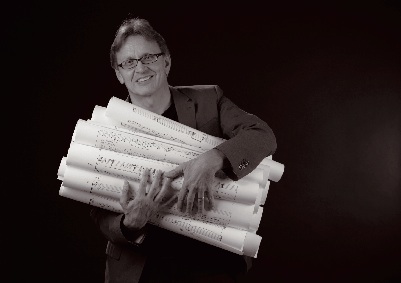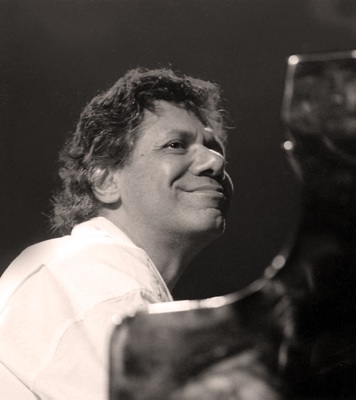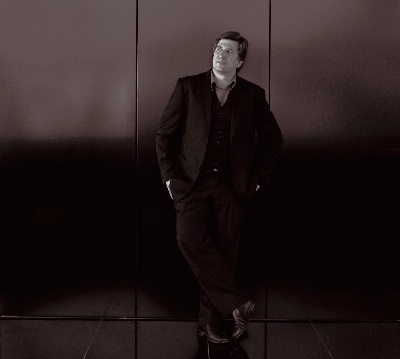
«Jazz Chamber Music» (or«Chamber Jazz») basically is the artful symbiosis of contemporary classical music with elements in the spirit of jazz such as groove and improvised sections, usually written for classical players with a jazz background. So this music incorporates grooves in an chamber music setting, meaning that groove elements from popular music are idiomatically converted for classical instruments.*)
This must not be mixed up with the attempts of so-called «cross-over»-music since Jazz chamber Music contains the harmonic and melodic influences from both contemporary classical music AND from Jazz; (It should be noted that the variety of «Jazz» is endless and very often confusingly open to styles and influences**).
The idea of blending these two worlds is not new. «Third Stream» was the name of the combination of European art music with Jazz In the 50s, initiated by Gunter Schuller.
For me, successful attempts of joining together the worlds of jazz and chamber music are, among others, many works of Chick Corea, Clare Fischer, Tim Garland, Gwylim Simcock and especially Billy Childs who has recorded several albums, even entitled «Jazz chamber music» (© to him!). They follow the tradition of «classical» composers like Ravel, Prokofiev, Stravinsky or Turnage who all continued the tradition which may have been started by Gershwin. Outstanding musicians like Leonard Bernstein and André Previn encompass not only their wide diversity in musical activities (as musicians and composers) but also their refusing to distinguish between «serious» and «light» music.
In Austria there are many prolific composers in Jazz Chamber music to be found; following the legacy of Friedrich Gulda and Werner Pirchner I would like to mention Roland Batik, Johannes Berauer, Bernie Mallinger, Christian & Wolfgang Muthspiel, Michael Radanovics, Tristan Schulze and especially Gernot Wolfgang, to mention just a few.
Musicians as well as the audience increasingly wish to expand their playing/ listening experiences. Now the classical repertoire will always have its place in the concert performances. Also, as exciting and adventurous contemporary «modern» music sounds, it still is of great importance to offer diversion with music that «reaches» the audience. «Jazz Chamber Music» fulfils exactly these demands and therefore is an extremely attractive style both for performing and listening.
Interestingly «Jazz Chamber Music» is not – yet? – being taught at universities at all, meaning improvisational and groove education for musicians and composers in a classical environment, and not of simply Jazz education. We have to consider the decreasing (or ageing) of the classical audience nowadays, so the main goal is to attract young people – e.g with rhythm and with the spirit of free expression! The style of Jazz chamber music will develop anyhow, so how cool would it be to start with education right away?
And the good thing is: It actually CAN be taught; My experience in this field span over many years and I sensed that musicians get better, the more open their musical spirit is allowed to be. Many classical musicians tremendously improve their musical expression when they get the opportunity to gather experience in groove and improvisation, while they stay what they are: great classical musicians, playing great classical music.
© by Michael Publig
* For example, a cool bass line can´t be transferred to a cello without adapting the music within the cello tradition and its idiom. «Jazz» also does not necessarily need «Swing» in a traditional sense – swing phrasing normally is played in triplets, such as in a Big Band groove. In fact, especially string players would have difficulties to generate Swing in this typical triplets feel. Which, on the hand, does not mean that there is no Swing at all. In fact, «Swing» can be heard since Bach in many different musical surroundings. In this context, «playing in time», i.e. playing without rubato, is essential to produce a groovy time-feel.
** Jazz chamber Music contains harmonic and melodic jazz influences, but it should be noted that the variety of «Jazz» is endless and very often confusingly open to styles and influences. «Jazz» in this context does not obligatorily need Blue notes or the half-tone–whole-tone scale but also may be influenced by bright Latin music, poly-rhythms, Ravel-like fine fourth-chords, Ligety-sh clusters, Post Viennese school twelve-tone rows as well as Samba rhythms and Flamenco chants.
Jazz Chamber Music
«Jazz Chamber Music» (oder«Chamber Jazz») ist eine kunstvolle Symbiose zwischen zeitgenössischer klassischer Musik, kombiniert mit Elementen aus dem Jazz wie zB. Groove und Improvisation. Werke dieses Genres sind üblicherweise für Klassische Musiker mit Jazz-Background komponiert. Diese Musik integriert Groove-Elemente in klassische Settings, was bedeutet, dass diese Elemente auf die Besonderheiten der klassischen Instrumente «übersetzt» werden. *
Daher sollte man diesen Stil keinesfalls mit sogenanntem «Cross-over» verwechseln, da Jazz Chamber Music eben harmonische und melodische Einflüsse sowohl aus der Klassischen Musik als auch dem Jazz enthält (und nicht lediglich rhythmisierte klassische Musik bedeutet). Dabei muss angemerkt werden, dass Jazz eine unglaubliche Fülle an Stilen und Einflüssen beinhaltet!
Die Idee, diese musikalischen Welten zu verbinden, ist nicht neu. «Third Stream» wurde diese Kombination aus Europäischer „Kunst“-Musik und Jazz in den 1950er-Jahren genannt, initiiert wurde diese Strömung von Gunter Schuller. Wie erfolgreich aus meiner Sicht diese Symbiose stattfinden kann, beweisen zahlreiche Werke von Chick Corea, Clare Fischer, Gwylim Simcock und vor allem Billy Childs, der nicht nur einige Alben aufgenommen hat, sondern diese tatsächlich «Jazz chamber music» betitelt hat (das © für die Bezeichnung gebührt also eigentlich ihm). Sie alle folgen einer Tradition Klassischer Komponisten wie Ravel, Prokofieff, Strawinsky oder Turnage, die alle wiederum jener Strömung folgten, die möglicherweise von Gershwin begründet wurde. Herausragende Musikerpersönlichkeiten wie Leonard Bernstein und André Previn waren nicht nur enorm vielseitig in ihren musikalischen Aktivitäten (als aktive Musiker wie als Komponisten), ihre Musik ignorierte zudem die Grenzen zwischen «E-» und «U-Musik».
Auch in Österreich findet sich eine wachsende Tradition in diesem Genre; Dem „Vermächtnis“ von Friedrich Gulda oder Werner Pirchner folgen Komponisten wie Roland Batik, Johannes Berauer, Bernie Mallinger, Christian & Wolfgang Muthspiel, Michael Radanovics, Tristan Schulze und v.a. Gernot Wolfgang, um nur einige der erfolgreichen zu nennen.
Sowohl MusikerInnen als auch das Publikum ist interessiert an einer Erweiterung der Spiel- bzw. Hörgewohnheiten. Nun wird das Klassische Repertoire stets seinen Stellenwert im Konzertgeschehen behalten, und so aufregend und abenteuerlich zeitgenössische «moderne» Musik auch klingen mag, so ist es von immenser Wichtigkeit, Abwechslung zu bieten mit Musik, die das Publikum «erreicht». Jazz Chamber Music erfüllt genau diese Anforderungen und ist daher sowohl für Ausübende wie Zuhörende ein äußerst attraktiver Stil.
Interessanterweise existiert jedoch (noch?) keine Ausbildungsmöglichkeit an den Universitäten, also ein Angebot für Musiker und Komponisten im klassischen Umfeld, ihre Groove- und Improvisationsskills zu entwickeln, und nicht lediglich eine Jazz Ausbildung. Dabei darf nicht außer Acht gelassen werden, dass das «klassische Konzertpublikum» älter wird und zahlenmäßig leider auch abnimmt; Es müssen also Maßnahmen gesetzt werden, um junges Publikum wieder für Konzerte zu interessieren, zum Beispiel durch Rhythmus und dem Geist des freien Ausdrucks. Das Genre Jazz Chamber Music wird fraglos seinen Weg in die Konzertprogramme finden – wie «cool» wäre es, eine entsprechende Ausbildung bereits jetzt anzubieten?
Die gute Nachricht ist: Man kann diese «Skills» tatsächlich unterrichten. Meine Erfahrung in diesem Gebiet erstreckt sich über mehrere Jahre und ich konnte dabei feststellen, dass MusikInnen umso besser werden, je offener sich ihr musikalische Geist ist entfalten kann. Viele klassischen Musiker verbessern ihren musikalischen Ausdruck enorm, wenn sie die Möglichkeit erhalten, Erfahrungen in Groove und Improvisation zu sammeln, während sie nach wie vor bleiben, was sie sind: Hervorragende klassische Musiker, die hervorragende klassische Musik spielen.
© by Michael Publig
* So kann beispielsweise eine coole Jazzbass-Linie nicht einfach 1:1 auf das Cello (oder das Fagott) übertragen werden, ohne in der jeweilige Spieltradition und seinem Idiom zu bleiben bzw. diese Musik speziell anzupassen oder mit anderen musikalischen Mitteln stiladäquat zu übersetzen.
SOME EXAMPLES:
CHICK COREA
https://www.youtube.com/watch?v=wlrU5pr7gCw
https://www.youtube.com/watch?v=c5HmXPnAq0M
BILLY CHILDS
https://www.youtube.com/watch?v=MaYGYVEZmTI
radio.string.quartet.vienna
https://www.youtube.com/watch?v=P09PeABhDPg
GERNOT WOLFGANG
https://www.youtube.com/watch?v=QTv1_uZJDqI
Johannes BERAUER/Gwylim SIMCOCK/Klaus GESING
https://www.youtube.com/watch?v=1unBijp9efM
VARIOUS (Zawinul, Gershwin, Corea, Childs u.a.)
Jazz Chamber Music with students live at the Porgy
Part 1: https://www.youtube.com/watch?v=IWEtsl16AN8
Part 2: https://www.youtube.com/watch?v=tNo81X8Zc8s
MICHAEL PUBLIG
https://www.youtube.com/watch?v=AsHK0JYUGUU
Jazz Chamber Music







Chick Corea
© by Wolfgang Gonaus
Billy Childs
© by Press foto
Gernot Wolfgang
© byLefteris fotography
Werner Pirchner
© by press foto
Gwylim Simcock,
Johannes Berauer
Michael Publig
© by private foto
Tristan Schulze
© by press foto
Michael Publig
© by Nancy Horowitz